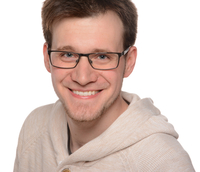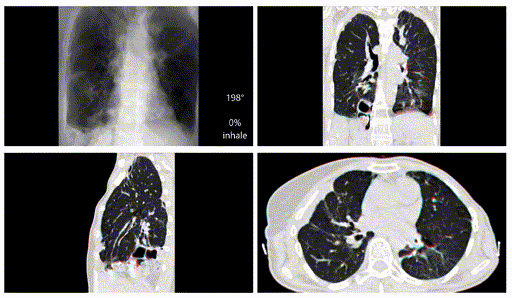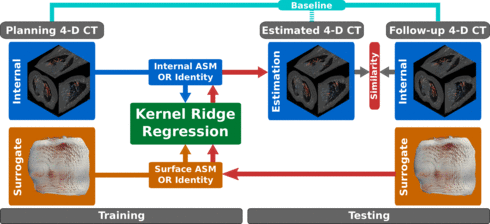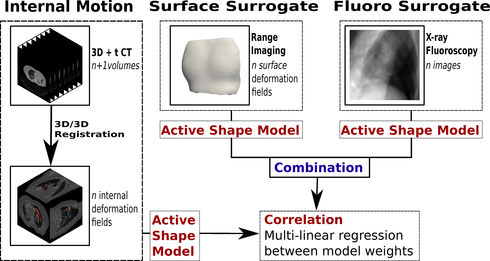
Tobias Geimer M. Sc.
Researcher in the Image Fusion (IMF) group at the Pattern Recognition Lab of the Friedrich-Alexander-Universität Erlangen-Nürnberg
T. Geimer, P. Keall, K. Breininger, V. Caillet, M. Dunbar, C. Bert, A. Maier
-

Data-driven respiratory signal extraction from rotational X-ray scans is a challenge as angular effects overlap with respiration-induced change in the scene. Conventional methods either provide only a 1D signal or are restricted to a static acquisition angle. By making use of the linearity of the X-ray transform, we aim to separate angular and respiratory variation by expressing them as the two domains of a bilinear model based on a prior 4D CT with corresponding rotational and respiratory feature space. The bilinear estimation process is supported by a B-spline interpolation using prior knowledge about the trajectory angle. Consequently, extraction of respiratory features simpli es to a linear problem. Though the need for a prior 4D CT seems steep, our proposed use-case of driving a respiratory motion model in radiation therapy usually meets this requirement.
Video: Bilinearly extracted respiratory features are used to drive a PCA-based motion representation trained from 4D CT to estimate 3D volumes of the patient's breathing state independently of the acquisition angle.
This work was partially conducted at the ACRF Image X Institute, University of Sydney as part of a visiting research scholar program.
T. Geimer, M. Unberath, A. Birlutiu, O. Taubmann, J. Wölfelschneider, C. Bert, A. Maier
-

In radiation therapy, tumor tracking allows to adjust the beam such that it follows the respiration-induced tumor motion. However, most clinical approaches rely on implanted fiducial markers to locate the tumor and, thus, only provide sparse information.
For estimation of dense internal deformation fields, patient-specific motion models have been proposed. The ground-truth deformation field is obtained from 4D imaging by registration to a reference phase. Recently, range imaging has emerged as a nonintrusive, markerless, high-dimensional surrogate suitable to drive said motion models. However, with increasing surrogate complexity, the challenge is to extract meaningful information from high-dimensional domains.
We present a respiratory motion estimation pipeline using kernel ridge regression to model the internal-external correlation, while also introducint non-linear mappings into the model. Evaluation was conducted in a study on five lung cancer patients. Each patient had at least two 4DCT acquisitions within eight weeks, allowing for strict separation of training on the planning CT and testing on a follow-up CTs. Thus, evaluation is closer to the actual application case than in previous studies where only one 4DCT was available.
Articles in Conference ProceedingsBildverarbeitung für die Medizin 2017, Heidelberg, Deutschland, 12.-14.03.2017, pp. 155-160, 2017, ISBN 978-3-662-54344-3 (BiBTeX, Who cited this?)Proceedings of the 2017 IEEE International Symposium on Biomedical Imaging (2017 IEEE International Symposium on Biomedical Imaging), Melbourne, Australia, 18.04.-21.04.2017, pp. 1036-1039, 2017 (BiBTeX, Who cited this?)
T. Geimer, M. Unberath, O. Taubmann, C. Bert, A. Maier
-

Respiratory motion drastically affects medical procedures in the thoracic and abdominal areas. In the context of medical imaging, breathing motion introduces data inconsistencies requiring the incorporation of motion models into state-of-the-art algorithms.
In external beam radiation therapy, the consequences of respiratory motion may be particularly harmful if not addressed properly. The patient is irradiated with photon or particle beams following an optimized fluence pattern that is the result of treatment planning based on CT imaging. However, respiratory motion typically leads to target volume displacement during irradiation, resulting in less than the therapeutic dose in the target and thus the potential survival of malignant cells. Consequently, real-time target motion detection is necessary to either pause the beam during certain parts of the cycle (gating) or to constantly adjust the fluence pattern following the target volume (tracking).
For real-time motion estimation a patient-specific motion model can be trained pre-procedurally, connecting a highly-correlated surrogate signal to the corresponding internal deformation. The ground-truth deformation field is usually obtained from 4-D imaging by registration to a reference phase.
We present a model to estimate dense 3-D internal motion fields from X-ray fluoroscopy without the need for implanted markers using dimensionality reduction and regression techniques. Further, to improve on estimation accuracy and stability the combination of multiple surrogates based on range imaging and fluoroscopy is investigated. Evaluation was performed in a simulation-study on nine 4-D CT patient data sets.
Articles in Conference ProceedingsComputer Assisted Radiology and Surgery (CARS) 2016: Proceedings of the 30th International Congress and Exhibition (Computer Assisted Radiology and Surgery (CARS) 2016), Heidelberg, 22.-25.06.2016, pp. 59-60, 2016 (BiBTeX, Who cited this?)

 +49 9131 85 28982
+49 9131 85 28982
 +49 9131 85 27270
+49 9131 85 27270

